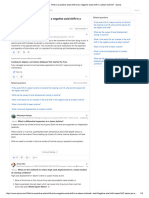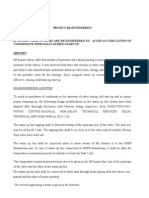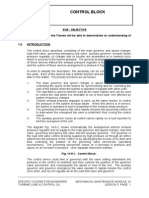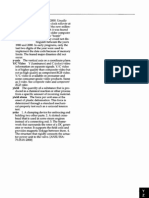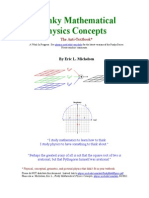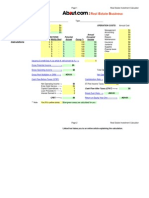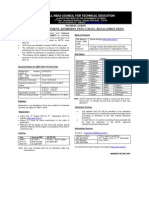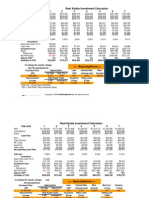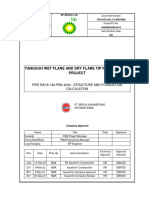EHTC
EHTC
Uploaded by
ewfsdCopyright:
Available Formats
EHTC
EHTC
Uploaded by
ewfsdOriginal Description:
Copyright
Available Formats
Share this document
Did you find this document useful?
Is this content inappropriate?
Copyright:
Available Formats
EHTC
EHTC
Uploaded by
ewfsdCopyright:
Available Formats
+team Turbine ,escription
Electro-hydraulic converter For Turbine control system
Function The electro-hydraulic converter is the connecting element between the electrical and the hydraulic parts of the turbine control system. It converts the signals coming from the electrical controller into hydraulic signals and amplifies them before transmitting them to the actuating elements. The signal of the hydraulic speed governor is amplified by this converter in case of operation with the hydraulic regulation. Construction The principal components of electro hydraulic converter are moving coil (8) , sleeve ( !), pilot valve ( ), amplifier piston ("), the follow up piston (#), differential transformer ( ) and mechanical feedbac$ lever (%). The
control signals from the electrical controller operate the sleeve ( !) via moving coil (8). This sleeve slides up and down on the top part of the pilot valve ( ) and determines the position of the pilot valve similar to the follow up piston. &ilot valve and the sleeve have ports which depending on the overlap, control the amount of au'iliary secondary oil flowing from connection (b ). In the steady state condition, the pilot valve is in its center position and oil pressure acting on top face of the pilot valve is in e*uilibrium with the force of the spring ( "). The pilot valve ( ) is $ept in rotation by control oil flowing from tangential holes in an integral collar to give greater freedom of reciprocal motion and achieve high response sensitivity.
,ifferential transformer " -mplifier piston # Follow up piston . +leeve / +haft 0 1ever % 1ever 8 2oving coil 3 4asing ! +leeve &ilot valve " +pring # -d5ustment screw . -d5ustment screw / Tension spring. (a) 4ontrol oil (b) +econdary oil (b ) -u'iliary secondary oil (c) 6eturn oil
$EC%I&' B-B
BHEL HARIDWAR
5.1- !" - "#1
7hen the pilot is deflected from its center position, control oil from connection (a) is admitted to the space above or below the amplifier piston (") whereas the opposite side of piston is connected with the return flow (c). The movement of amplifier piston is transmitted via lever (0) to the sleeve (.), which in turn slides on the follow piston (#). The secondary oil circuits, which are fed from the trip oil circuit via throttles and supply the various actuating devices are connected to connections (b). The secondary oil pressures are determined by the tension of springs ( /) which counterbalance the oil pressure acting on the follow up pistons. 8ach follow up piston (#) and sleeve (.) have ports, which control the secondary oil flow according to overlap. 7hen the throttling area is changed by the movement of sleeve (.) it also changes the pressure in follow up piston causing it to follow the movement of the sleeve. This varies the tension of springs ( /) until e*uilibrium is regained between the spring force and the new secondary oil pressure. 8ach position of amplifier piston (") corresponds to a specific position of the sleeve (.) and thus also the follow up piston (#). The position of follow up piston is determining factor for the secondary oil pressure at the connections (b) The initial tension of the follow up piston springs can be changed with the help of ad5ustment screws ( .). Control action (ith electrical controller 7hen the electrical controller gives a command to open the control valves, the sleeve ( !) moves down by the moving coil system (8) and thus changes the oil drain cross section through the ports. The pressure over the pilot valve ( ) in this way rises so that the pilot valve slides down and opens the path for control oil from connection (a) to flow to the space above the amplifier piston ("). The movement of piston (") pushes the lever (0) and the sleeve (.) downward and thus reduces the drain cross section between the sleeves (.) and the follow up piston (#) so that the pressure in the follow up piston and thus in the secondary oil circuits rises. The movement of amplifier piston (") produces a simultaneous feedbac$ action on the pilot valve ( ) via the differential transformer ( ) and lever (%). The sleeve ( !) moved bac$ until the new position of the amplifier piston causes the pilot valve ( ) to assume its center position and e*uilibrium is restored between the oil pressure over the pilot valve and the spring force ( "). The process proceeds accordingly in reversed manner in case of a command for the closing of the control valves is given.
5.1- !" - "#*
Controllin) action (ith hydraulic )overnor If the hydraulic governor is not in operation, the sleeve ( !) is in its lower end position. The pressure over the pilot valve ( ) is now changed by the hydraulic governor through the change in au'iliary secondary oil pressure (connection (b )). -n increase in au'iliary secondary oil pressure causes the secondary oil pressures on the connection (b) to rise and thus the opening of the control valve servomotors. - reduction in secondary oil pressure causes closing of the control valve servomotors. In case of operation with hydraulic governor the mechanical feedbac$ lever (%) is effective, which causes the pilot valve to assume its center position when the new position of the amplifier piston (") is reached with respect to the au'iliary secondary oil pressure. 8ach au'iliary secondary oil pressure corresponds to a certain position of amplifier piston, which in turn, results in a certain secondary oil pressure at connection (b). The degree of proportionality of hydraulic governor can be ad5usted by varying the position of rotation of the lever (%) with the help of the ad5ustment screw ( #).
$ection A-A
You might also like
- 2007 Ssang Yong Rexton Y270 Owner ManualDocument626 pages2007 Ssang Yong Rexton Y270 Owner Manualbogdanxp20000% (1)
- CMC PresentationDocument34 pagesCMC PresentationSandeep Kumar Sinha100% (3)
- Standard Operating Procedure: Adhunik Power & Natural Resources LTDDocument1 pageStandard Operating Procedure: Adhunik Power & Natural Resources LTDApnrl maincontrolroomNo ratings yet
- Climatronic Control Audi A4 b6Document189 pagesClimatronic Control Audi A4 b6Pancescu Marian33% (3)
- Ariel Start-Up Check List (Er-10.4.0)Document6 pagesAriel Start-Up Check List (Er-10.4.0)Jose RattiaNo ratings yet
- Load To Motor Inertia Mismatch: Unveiling The TruthDocument13 pagesLoad To Motor Inertia Mismatch: Unveiling The TruthDaniel SileshiNo ratings yet
- Dayton Superior Bar-Lock Coupler SystemDocument4 pagesDayton Superior Bar-Lock Coupler SystemJosh ReynoldsNo ratings yet
- New EHC For KWU GoverningDocument13 pagesNew EHC For KWU GoverningMohammad Ibnul Hossain100% (2)
- 210 MW Seal Oil SystemDocument6 pages210 MW Seal Oil Systemmag_ktps20021520100% (3)
- Standard Operating Procedure For Hy-Lp Bypass System: ObjectiveDocument8 pagesStandard Operating Procedure For Hy-Lp Bypass System: ObjectiveSonratNo ratings yet
- Ing The Starting Device To Zero: M.S. Pr. 35-40 Ksc. HRH Pr. 12-14 Ksc. M.S. and HRH Tempr. - 320 To 3500C)Document3 pagesIng The Starting Device To Zero: M.S. Pr. 35-40 Ksc. HRH Pr. 12-14 Ksc. M.S. and HRH Tempr. - 320 To 3500C)Sourav SahaNo ratings yet
- Dadri Coal Failure of Electro Hydraulic Converter Ehc Follow Up PistonDocument6 pagesDadri Coal Failure of Electro Hydraulic Converter Ehc Follow Up PistonNIKHIL KSHIRSAGAR100% (1)
- Starting Device Not Operating From Control Room &EHTC HuntingDocument5 pagesStarting Device Not Operating From Control Room &EHTC HuntingCharu Chhabra100% (2)
- What Is A Positive Axial Shift and A Negative Axial Shift in A Steam Turbine - QuoraDocument6 pagesWhat Is A Positive Axial Shift and A Negative Axial Shift in A Steam Turbine - QuoraSasi NimmakayalaNo ratings yet
- Turbine MalDocument29 pagesTurbine Maldurga praveenNo ratings yet
- Write Up ON Electrohydraulic Turbine Controller (Ehtc) : Reference DocumentsDocument37 pagesWrite Up ON Electrohydraulic Turbine Controller (Ehtc) : Reference Documentsd_tantubai100% (1)
- KWU Turbine Governing SchemeDocument17 pagesKWU Turbine Governing Schemesunil100% (2)
- Tslle & Turbine ProtectionDocument37 pagesTslle & Turbine ProtectionAurobinda Mishra100% (1)
- Governing KWU CBT VidyasDocument35 pagesGoverning KWU CBT VidyasAbhishek Prakash SrivastavaNo ratings yet
- C&IDocument28 pagesC&ISam100% (2)
- Boiler Drum Level ControlDocument9 pagesBoiler Drum Level Controlsekhar_ntpcNo ratings yet
- CMC FinalDocument30 pagesCMC FinalSam100% (1)
- Problem Faced in Turbine Governing System During Commissioning of TDBFPDocument5 pagesProblem Faced in Turbine Governing System During Commissioning of TDBFPCharu Chhabra100% (2)
- EHTCDocument22 pagesEHTCVicky Singh100% (4)
- Turbine Stress Evaluator PDFDocument16 pagesTurbine Stress Evaluator PDFLakshmi Narayan100% (1)
- Presentation OnDocument28 pagesPresentation OnAnonymous umnT4ZZcuNo ratings yet
- Simulation of Electro-Hydraulic Turbine Control (EHTC) SystemDocument8 pagesSimulation of Electro-Hydraulic Turbine Control (EHTC) SystemShwethaNo ratings yet
- Governing KwuDocument21 pagesGoverning KwuVishal Kumar Laddha100% (4)
- Hydraulic Low Vacuum Trip Device FailureDocument3 pagesHydraulic Low Vacuum Trip Device Failuretsrinivasan5083100% (3)
- ATT Stop and Control Valves-WriteupDocument3 pagesATT Stop and Control Valves-WriteupErwin Fernandes Gurning100% (1)
- Governing 11Document35 pagesGoverning 11rahul100% (3)
- TDBFP Over Speed ProtocolDocument2 pagesTDBFP Over Speed ProtocolAnoop Kumar AllankiNo ratings yet
- DC-AC Fail Work InstructionDocument23 pagesDC-AC Fail Work InstructionShiftinchargeengineer dadri coal100% (1)
- 020-SOP of H2 CYLINDER Room ChargingDocument4 pages020-SOP of H2 CYLINDER Room Chargingsambhu100% (1)
- Npti 20072010Document19 pagesNpti 20072010Sai SwaroopNo ratings yet
- 800 MWDocument6 pages800 MWRamesh Babu K100% (2)
- Automatic Turbine Run-Up SystemDocument22 pagesAutomatic Turbine Run-Up SystemSam100% (2)
- TSC 2Document15 pagesTSC 2Manoj UpadhyayNo ratings yet
- BHELVISIONDocument48 pagesBHELVISIONExecutive EngineerNo ratings yet
- 3 Element Boiler Drum LevelDocument2 pages3 Element Boiler Drum LevelAmir Yousaf100% (1)
- Safety Valve Floating MrthodDocument4 pagesSafety Valve Floating MrthodSanjay Chakraborty100% (1)
- Design Features of Governing System LMW and Kwu TurbinesDocument34 pagesDesign Features of Governing System LMW and Kwu Turbinespankaj100% (2)
- CEP Isolation & Normalisation ProcedureDocument2 pagesCEP Isolation & Normalisation ProcedureVishal GuptaNo ratings yet
- C&I Part of SCDocument28 pagesC&I Part of SCSam100% (3)
- C&I Part of SCDocument28 pagesC&I Part of SCLakshmi Narayan100% (1)
- HP Bypass Warm Up Lines Re Engineering To Prevent Condensate Accumulation, 97-98Document4 pagesHP Bypass Warm Up Lines Re Engineering To Prevent Condensate Accumulation, 97-98Charu Chhabra0% (1)
- Technical Feedback On EHCDocument8 pagesTechnical Feedback On EHCvesridhar100% (2)
- KWU Steam Turbine Governing System 210 X 4 MW HtpsDocument86 pagesKWU Steam Turbine Governing System 210 X 4 MW HtpsAneesh CR100% (4)
- DEH PresentationDocument37 pagesDEH PresentationPRAMOD KUMAR NANDA100% (4)
- Cold Start Up Procedure: - NTPC, SimhadriDocument29 pagesCold Start Up Procedure: - NTPC, SimhadriAhemadNo ratings yet
- Turbine Gate Valve Gearing (Turning Gear)Document5 pagesTurbine Gate Valve Gearing (Turning Gear)Sai Swaroop67% (3)
- Kwu Governing SystemDocument25 pagesKwu Governing SystemLakshmi Narayan100% (2)
- Technical Feedback EhtcDocument9 pagesTechnical Feedback EhtcPrashant Kumar ChoudharyNo ratings yet
- Emergency Operations: Shaikh Feroz AliDocument15 pagesEmergency Operations: Shaikh Feroz AliEXECUTIVE ENGINEEER BOILER MAINTENANCENo ratings yet
- Seal Oil Systems Stage - 1Document34 pagesSeal Oil Systems Stage - 1raghavendran raghu100% (4)
- EHTC O&M-edn PDFDocument24 pagesEHTC O&M-edn PDFprasanta_bbsr100% (1)
- Vaccuum Killing and PullingDocument2 pagesVaccuum Killing and PullingMY NAME IS NEERAJ..:):)100% (2)
- 500MW Boiler Fans and ProtectionsDocument5 pages500MW Boiler Fans and Protectionsshashank100% (1)
- TSE - Nirav JoshiDocument81 pagesTSE - Nirav JoshiBrahma Dutt100% (1)
- Operation and Protection of 210 MW Turbine Condensation Extracton Pump and Condensation CycleDocument31 pagesOperation and Protection of 210 MW Turbine Condensation Extracton Pump and Condensation CycleAshish Lanjewar100% (3)
- Bhel Steam Turbine Description-1Document2 pagesBhel Steam Turbine Description-1Srinivasa Rao Pallela100% (1)
- Control Valve ServomotorDocument1 pageControl Valve ServomotorPopeyeElectricman100% (1)
- Lesson Control BlockDocument10 pagesLesson Control Blockmister pogiNo ratings yet
- Att System OperationDocument41 pagesAtt System OperationchanlinNo ratings yet
- Lesson Main Stop Valve & Servomotor, Governing Valves and ServomotorDocument41 pagesLesson Main Stop Valve & Servomotor, Governing Valves and Servomotormister pogi100% (3)
- Barbara PeaseDocument1 pageBarbara PeaseewfsdNo ratings yet
- Dictionary - Industrial Automation and ControlDocument456 pagesDictionary - Industrial Automation and ControlApagutankodauda100% (2)
- Nila Chakra BhajansDocument1 pageNila Chakra BhajansewfsdNo ratings yet
- Point Worth PonderingDocument3 pagesPoint Worth PonderingewfsdNo ratings yet
- Preface To The Fourth Edition VDocument1 pagePreface To The Fourth Edition VewfsdNo ratings yet
- Y2K Year 2000. Usually: RGB VideoDocument1 pageY2K Year 2000. Usually: RGB VideoewfsdNo ratings yet
- Funky Math PhysicsDocument205 pagesFunky Math PhysicsFredrick MutungaNo ratings yet
- WWW - Imdorissa.gov - in Data Wfishermen - HTMDocument1 pageWWW - Imdorissa.gov - in Data Wfishermen - HTMewfsdNo ratings yet
- Property Info: Operation CostsDocument2 pagesProperty Info: Operation CostsewfsdNo ratings yet
- Notification Common Management Admission Test (Cmat) - 2013-14 (First Test)Document4 pagesNotification Common Management Admission Test (Cmat) - 2013-14 (First Test)ewfsdNo ratings yet
- Real Estate Investment Calculator: Year-End 1 2 3 4 5 6 7Document3 pagesReal Estate Investment Calculator: Year-End 1 2 3 4 5 6 7ewfsdNo ratings yet
- Mobile Prepaid ServicesDocument8 pagesMobile Prepaid ServicesewfsdNo ratings yet
- National Innovation FoundationDocument5 pagesNational Innovation FoundationewfsdNo ratings yet
- M Tech and PHD ProjectsDocument1 pageM Tech and PHD ProjectsewfsdNo ratings yet
- Vespa S 125 - 150 I.E. (EN)Document270 pagesVespa S 125 - 150 I.E. (EN)Manualles50% (2)
- Mec404 TH 226 2Document6 pagesMec404 TH 226 2commander91gamingNo ratings yet
- PG3 Rect-BeamDocument28 pagesPG3 Rect-BeammuruNo ratings yet
- Chemistry For Engineers - ThermochemDocument3 pagesChemistry For Engineers - ThermochemCharles Augustus100% (2)
- VRF Installation Quick GuideDocument84 pagesVRF Installation Quick GuideErwin MaldoNo ratings yet
- Study On Soil Investigation of Habitat Iluminar: The and Tests ResultsDocument6 pagesStudy On Soil Investigation of Habitat Iluminar: The and Tests ResultsShashi Kumar NNo ratings yet
- ASCO Hazardous Location CatalogDocument16 pagesASCO Hazardous Location CatalogMatt EbrahimiNo ratings yet
- Aa Pka-Rp100kal - Puhz-P100yhaDocument2 pagesAa Pka-Rp100kal - Puhz-P100yhaVíctor RomeuNo ratings yet
- Pipeline Design Consideration and StandardsDocument50 pagesPipeline Design Consideration and StandardsahmadNo ratings yet
- Ductulator - Air Duct CalculatorDocument1 pageDuctulator - Air Duct CalculatorCarlos R. SantiagoNo ratings yet
- Rotork CatalogDocument12 pagesRotork CatalogKedar PatwardhanNo ratings yet
- Ee8401 - em Ii - Question Bank - Unit5Document5 pagesEe8401 - em Ii - Question Bank - Unit5DEVINo ratings yet
- Utilities and Utilities Targeting: Utilities For A ProcessDocument17 pagesUtilities and Utilities Targeting: Utilities For A ProcessPosea ConstantinNo ratings yet
- Tutorial 1Document3 pagesTutorial 1Nikhil ChhatriNo ratings yet
- I-Vtec Report FileDocument36 pagesI-Vtec Report FilePriya TiwariNo ratings yet
- Stiffness Part 3Document35 pagesStiffness Part 3Abhi EsNo ratings yet
- Truck Tire Operator's Manual and Limited WarrantyDocument19 pagesTruck Tire Operator's Manual and Limited WarrantyМИНИОНNo ratings yet
- Tutorial 1 10Document3 pagesTutorial 1 10Marlon BoucaudNo ratings yet
- YZ250F B7B2 - 2019 CompressedDocument63 pagesYZ250F B7B2 - 2019 CompressedRepuestos.Florencia M.FNo ratings yet
- H2 & Seal Oil SysDocument33 pagesH2 & Seal Oil Syssanmukha100% (2)
- 2012 A5 Product Catalogue FULLDocument115 pages2012 A5 Product Catalogue FULLAnonymous 4MLEo9TVQNo ratings yet
- A New Methodology For Aerodynamic Design and Analysis of A Small Scaleblended Wing Body 2168 9792 1000206 PDFDocument6 pagesA New Methodology For Aerodynamic Design and Analysis of A Small Scaleblended Wing Body 2168 9792 1000206 PDFhiral gohilNo ratings yet
- Tgh-070-Cal-cv-bei-0006 Rev c02 - Pipe Rack 186-Prk-4006 - Structure and Foundation CalculationDocument256 pagesTgh-070-Cal-cv-bei-0006 Rev c02 - Pipe Rack 186-Prk-4006 - Structure and Foundation Calculationlabkraf.indonesiaNo ratings yet
- BHCN 2700 TS 20249C 1020 EnglishDocument40 pagesBHCN 2700 TS 20249C 1020 EnglishandersonNo ratings yet
- Molecular Thermodynamics of Fluid-Phase Equilibria: Solutions Manual To AccompanyDocument195 pagesMolecular Thermodynamics of Fluid-Phase Equilibria: Solutions Manual To AccompanyarianNo ratings yet













